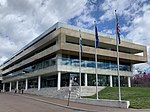Chesapeake and Ohio Canal National Historical Park
1938 establishments in Washington, D.C.All pages needing cleanupBuildings and structures in Hagerstown, MarylandCanal museums in the United StatesCanals on the National Register of Historic Places in Maryland ... and 26 more
Canals on the National Register of Historic Places in VirginiaCanals on the National Register of Historic Places in Washington, D.C.Chesapeake and Ohio CanalChesapeake and Ohio Canal National Historical ParkCumberland, MarylandHistoric districts in Morgan County, West VirginiaJourney Through Hallowed Ground National Heritage AreaLong-distance trails in the United StatesNational Historical Parks of the United StatesNational Park Service areas in Washington, D.C.National Register of Historic Places in Allegany County, MarylandNational Register of Historic Places in Frederick County, MarylandNational Register of Historic Places in Morgan County, West VirginiaNational Register of Historic Places in Washington County, MarylandNational parks of the AppalachiansParks in Allegany County, MarylandParks in Cumberland, MD-WV-PAParks in Frederick County, MarylandParks in Montgomery County, MarylandParks in Washington, D.C.Parks in Washington County, MarylandParks on the National Register of Historic Places in MarylandParks on the National Register of Historic Places in VirginiaParks on the National Register of Historic Places in Washington, D.C.Parks on the National Register of Historic Places in West VirginiaProtected areas established in 1938

The Chesapeake and Ohio Canal National Historical Park is located in the District of Columbia and the state of Maryland. The park was established in 1961 as a National Monument by President Dwight D. Eisenhower to preserve the neglected remains of the Chesapeake and Ohio Canal and many of its original structures. The canal and towpath trail extends along the Potomac River from Georgetown, Washington, D.C., to Cumberland, Maryland, a distance of 184.5 miles (296.9 km). In 2013, the path was designated as the first section of U.S. Bicycle Route 50.
Excerpt from the Wikipedia article Chesapeake and Ohio Canal National Historical Park (License: CC BY-SA 3.0, Authors, Images).Chesapeake and Ohio Canal National Historical Park
Rock Creek Trail, Washington Foggy Bottom
Geographical coordinates (GPS) Address Nearby Places Show on map
Geographical coordinates (GPS)
| Latitude | Longitude |
|---|---|
| N 38.899722222222 ° | E -77.057777777778 ° |
Address
Lock 0 (Tidewater Lock)
Rock Creek Trail
20566 Washington, Foggy Bottom
District of Columbia, United States
Open on Google Maps









